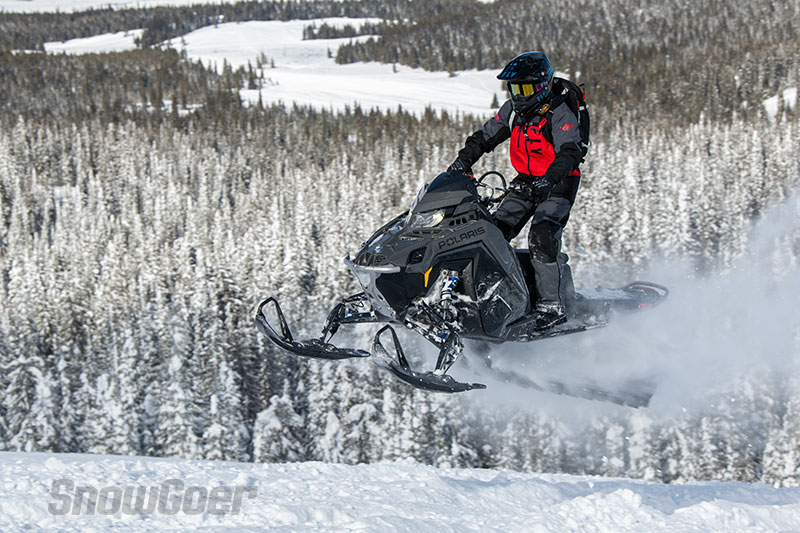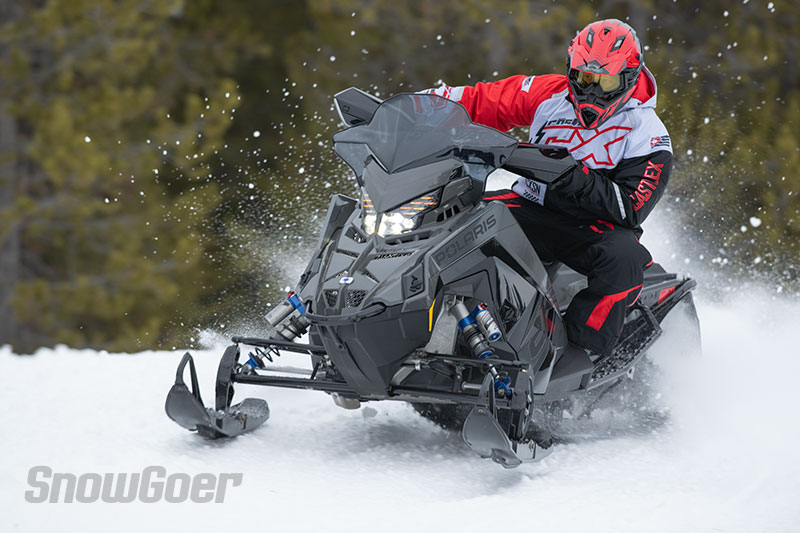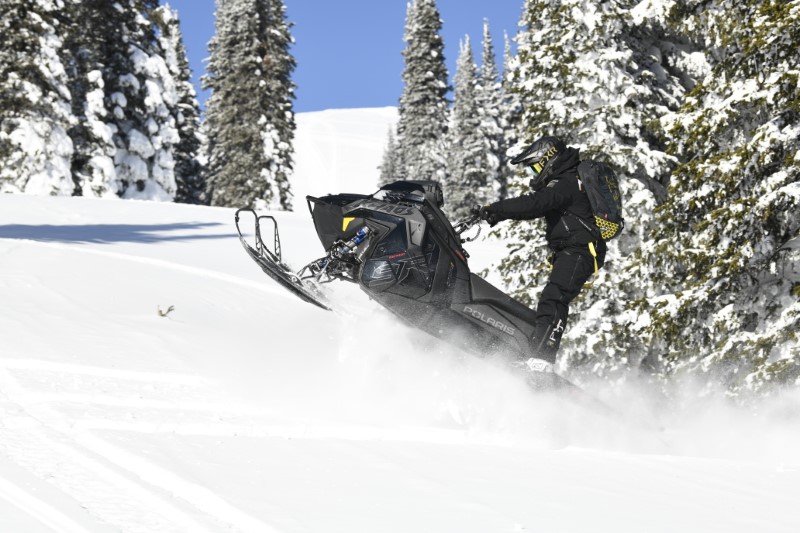EDITORS NOTE: This article about the creator of the first Polaris snowmobile – the affable David Johnson – first appeared in the March 2014 issue of Snow Goer magazine. Recently, it won a gold medal for profile writing at the Minnesota Magazine and Publications Association awards.
“David, David, David” I said. I shook my head and looked down, to the hulking machine on our shop floor. Anger isn’t the proper word to describe my emotions, but I certainly was miffed at my long-time friend and brother-in-law. I was feeling many emotions — confusion, bewilderment, perhaps dismay. Only earlier that day, in the winter of 1955, I’d returned from a long-needed vacation to California, where my wife’s sister lived. Refreshed and at relative peace, I was now back at the factory, which we’d recently expanded…. From the success of our straw choppers, we’d climbed to the point where we had a little money, though we still sweated out each payday…. But now, what the heck was David doing? How had he managed to build this thing in the few days I was gone? Vanished was my peaceful feeling.

“Edgar,” he had said, “I built something… It’s a snow machine.”
— Edgar Hetteen, in Breaking Trail
The 90-year-old man sitting casually at a table with a cup of coffee certainly didn’t look like a corporate big shot. With his casual shirt, scuffed shoes and small-town demeanor, David Johnson didn’t ooze wealth, and he seemed quite content with the simple bagel in front of him. He came across as just a regular guy, and truth be told, he wouldn’t have it any other way. He’s always been a common guy, not someone who’s ever been comfortable making big speeches, doing corporate presentations or promoting himself.
Maybe it’s that passive nature that has helped make him, however unfairly, one of the most overlooked people in the history of snowmobiling, despite his central role in defining the sport and then growing one of the sport’s largest companies.
When telling the history of the snowmobile industry, some people see Carl Eliason as the inventor of the snowmobile; others credit J. Armand Bombardier, Mike Bosak or Edgar Hetteen. What’s often forgotten, however, is that David Johnson made the first Polaris snowmobile in 1955 when his business partner Edgar Hetteen was out of town, and before Bombardier’s single-passenger Ski-Doos were launched in far-away Quebec. And, in an often-told story by Hetteen himself, Edgar was not pleased about David’s little side project, thinking his longtime friend was wasting his time when he should have been focusing on agricultural equipment.

Instead, Johnson’s hand-built creation helped determine a whole winter lifestyle in the Snowbelt, and changed Polaris from a regional maker of farm equipment to a powersports powerhouse that now has more than $3 billion in annual sales.
Eliason, Bombardier and Bosak each died decades ago, and the snowmobile industry lost Edgar Hetteen early in 2011. But Johnson lives on and rides on — more than 1,500 miles last winter, held short of his usual 2,000-plus snowmobiling miles only by the late arrival of snow in his native Northwestern Minnesota, Johnson said as we visited at the Polaris Experience Center in September. Age has caused the answers to our questions to come a little slower these days, but Johnson’s memories are still sharp, and his ties to the company he helped start are still strong. After more than 50 years at Polaris, he’s technically retired, but he’s certainly no stranger at the Polaris factory — he stops in several times per week for coffee, to check in on old friends or to occasionally lead a tour.
Though not played up in history books, he remains arguably the most popular man in Polaris’ long history to the people who have worked at the factory, and one of the planet’s most dedicated snowmobilers.
The Invention
Many history books, Wikipedia pages and even his plaque at the Snowmobile Hall Of Fame list Edgar Hetteen as “the father of the snowmobile,” but Hetteen’s own book set the record straight: It was David Johnson who sired what is now referred to as No. 1, and was instrumental in building No. 2 — the machine built for the third business partner in Polaris, Edgar’s brother Allan Hetteen.
Looking back now, the engaging Johnson downplays his inventiveness.
“We were pretty much outdoors people, and we did quite a bit of hunting in the Northwest Angle [on the Minnesota/Manitoba border] for all kinds of game,” Johnson recalled between sips of coffee, his vivid blue eyes bright behind his trademark oversized eyeglasses. “We had a lot of snow in some of those winters, so you had to go on snow shoes or walk or whatever. So, I used to tell people that we were lazy, we didn’t want to walk, so we had to think of something we could ride on.”
At that point, large tracked vehicles from companies like Bombardier Inc. were already being used as school buses in snowy areas, and some folks had tried putting tracks and skis on automobiles and such, but personal over-snow transportation was still rather evasive.
“I got a view of some people that had been working on the kind of machine that would go in the snow, so I guess I got to thinking, ‘What can we build?’” Johnson said. “That’s how it started.”
At the time, the recently renamed Polaris Industries (it had been Hetteen Hoist & Derrick from its start in 1945 until the spring of 1954) was in the agricultural equipment business, and that gave Johnson access to raw materials he pieced together to build his snowmobile while Edgar was in California.
“We used steel roller chain for the track, and then we welded cleats across that, about a one and one-sixteenth-inch cleats — we used several of those,” Johnson said, sharing the credit with then Polaris workers Orlen Johnson and Paul Knochenmus. “We used sprockets in the front and the back like we were using in farm machinery.”
Power came from a Briggs & Stratton engine Johnson bought off the shelf at the local hardware store.
“So we tried that and put it out in the snow, and it didn’t go anyplace,” he said, flashing a broad smile. Different lengths of chain were tried, skis made from a halved car bumper were installed up front, but the major problem was that when the engine torqued the track, that track would try to pull the sprockets toward one another causing the track to bow up at the center, Johnson said.
The solution was the first pair snowmobile slide rails, made out of material readily available on the shop floor. “We took some 2-by-2 that we bolted it between — just scrap wood, because that’s what we had,” Johnson said. “That was it, now it would move, it would go.”
Then Edgar came home, and voiced his displeasure. He did not, however, make Johnson shelve the project.
Well, I ignored the machine for a week. If David wanted one for his own amusement, so be it. It wasn’t as if he’d cost us much money, just his time, and he more than made up for that by working day and night, as we all did. Let him have his toy. The days passed, and David continued work on the machine he called a Motor Toboggan. More and more, in spite of myself, I was drawn to it. — Edgar Hetteen, in Breaking Trail
The Start Of A Business
Testing the snow vehicle led to more testing.
A drive system with homemade CVT clutches was added, different track lengths were tried and speeds increased from an initial 4-6 mph to over 20 mph, Johnson said.
Johnson’s plan all along was merely to build a machine for himself, but a funny thing happened along the way.
“Pete Peterson had a lumber yard across the street from Polaris at that point, and he was also an avid hunter, he would hunt rabbits and fox and things like that,” Johnson said. “He saw this machine and wondered if he could buy it. We said, ‘Well, we don’t have any to sell, we just have this one.’ But he wanted to buy it. I told him, ‘Pete, it is not a proven machine.’ But he said, ‘I want to buy it.’ So he gave us $465 for it, which paid for the motor and the iron we had into the chassis.”
As much as Peterson was the first customer, he was also the guinea pig, breaking various parts, getting stuck far too often and always coming back to Johnson and the crew at Polaris looking for help.
“I would say, ‘Now Pete, stay close enough to the road where we can at least get ahold of it,’” Johnson said. “Well, he wouldn’t do that, and pretty soon, Pete would come with a shovel and we’d have to get it out of there.”
In the meantime, Johnson, Allan Hetteen and Albin Erickson started working on a second snowmobile at Polaris, this one allegedly for Allan.
“There was this fellow, Harley Jensen, who lived on an island up in the Northwest Angle, and he’d walk [or snowshoe or ski] for miles to the mainlands to cut pulp,” Johnson recalled. “He heard about our machine and said, ‘I’d like to have a machine like that.’ I said, ‘Well, we don’t have one, but we could make some more.’ Well, Edgar heard that and said, ‘We’ve got a machine — we’ve got Allan’s.”
With Allan Hetteen out of town delivering straw choppers, Edgar Hetteen and Johnson loaded the big iron horse on a truck and drove to meet Jensen. This machine had several advancements, including a huge hood and windshield to protect the driver from the elements. That very machine is currently at the Polaris Experience Center in Roseau, Minnesota, and Johnson sat on it to explain the test drive he gave Jensen almost 58 years earlier, in February of 1956.
“He sat behind me and I sat in front to drive it and show him how it works,” Johnson explained. “We got going but then one of the throttle cables broke. So, here we were, going what we thought was pretty fast — probably 20 mph — and the throttle [was stuck wide open]. I had to reach past Harley just like this so I could pull the spark plug wire,” he said, keeping one hand on the steering wheel (not a handlebar) while twisting and reaching around an imaginary passenger.
“That was the only way to stop it. But he wanted to buy it anyway,” Johnson said through a laugh.
Suddenly, Polaris was in the snowmobile manufacturing business.
Upon selling No. 2, I started to really like this little snow machine. I thought about its potential. While it was true our straw choppers were doing well, the upside of the snowmobile seemed too great to ignore. The machine finally won me over, and it wasn’t long before I divorced myself from the straw chopper side of the business and worked full time on our motor toboggans.” — Edgar Hetteen, in Breaking Trail
Johnson’s Place In History
When most people tell the history of snowmobiling, and most notably the history of both Arctic Cat and Polaris, Edgar Hetteen’s trans-Alaskan trip in March of 1960 plays a central role. But David Johnson’s many benchmarks are often overlooked.
Johnson was Polaris’ first racer — showing up at the annual dogsled races at The Pas, Manitoba, and beating the first Bombardier Ski-Doo snowmobiles at the time. After the win, the Ski-Doo broke down and was towed in by Johnson’s Polaris, to the catcalls of the amused crowd.
Soon after Edgar Hetteen returned from his Alaskan adventure, a conflict with board members caused Edgar to leave the company, and his brother Allan became the new Polaris president. The snowmobile business expanded rapidly, as new brand names started coming out of small towns across the Snowbelt, snowmobile racing started drawing big crowds and Polaris went through many changes. Johnson’s first snowmobile helped change Polaris from an agricultural company to a full-time snowmobile manufacturer working out of a 100,000 square-foot factory by 1967.
Despite its success, Polaris often struggled with cash flow issues, but that was solved when the company became part of the Textron Corporation in 1968. After Allan Hetteen’s death in 1973, Johnson was the only remaining member of Polaris’ three original partners still with the company, but he never became the company president. Instead, he was always in charge of the factory. That maybe helps explain why his name doesn’t roll off the lips when many observers name the legendary snowmobiling pioneers. But in Roseau, Minnesota, Johnson truly is a beloved hero and legend.
“David was never the company spokesman or president or anything — Allan was known as the businessman, and Edgar was the marketing frontman, but David was the guy that was the glue,” explained Ed Skomoroh, a retired Polaris executive and historian.

“No matter how bad things were or how good they were, he kept sense and unity in production. And when the money got tight and Polaris couldn’t make payroll, the people would come in and work anyway. Many of those people weren’t working for Polaris, from their perspective: They were working for David. They respected David as a person, and they knew that he would make sure they were taken care of.”
While other Polaris leaders chased racing across the country through the glory days of the 1970s, Johnson would most often be found back in Roseau, keeping things running at the factory.
“We branched out into foreign countries and everything. My job was to make sure that we made a better machine and improved it and hired people to go to work for you,” Johnson said. “Everything had to improve, the machines, our equipment and everything. We started using different engines and we bought presses. The machines got lighter so we could go faster, and they were better handling and the whole works.”
Beyond that, when not working, Johnson said he always would rather be riding than watching others race.
“Yeah, we found out that it was fun!” he said through a laugh. “We all went out on these machines. My wife and I, and my kids grew up around these machines. It became something you wanted to do.”
Johnson retired in 1988 — the company created a full-page ad in his honor, under the headline reading, “Thanks David, it would have been tough sledding without you.” Truly, that was just a technicality, however. Johnson was still at the factory on a daily basis for the next 20 years, serving as an ombudsman for employees and an advisor on countless things when asked.
“He was a shop floor go-to person,” said Marlys Knutson, Polaris’ communications manager. “If somebody couldn’t figure something out, David usually had a common-sense solution.”
David Johnson, Today
Walking through the Polaris Experience Center, past machines that helped build both Polaris’ history and that of the snowmobile industry, David Johnson shared background stories on the importance of select models — stopping and talking at length where the disastrous 1964 Colt that almost bankrupt the company sat next to the ultra-successful 1965 Mustang that saved the company.
Johnson passed speed run sleds like the sloped-nose Polaris X-2 and old Midnight Blue Express machines, still stickered up and looking ready to race, and also quickly moved past some early Polaris ATVs and off-road vehicles that drive most of Polaris’ profit today. Instead, he was drawn most to the regular trail machines that helped define the sport and Polaris.
 From its simple beginnings, Polaris has grown into a huge international company, with factories in faraway places like Mexico and Poland, and more than 4,000 employees.
From its simple beginnings, Polaris has grown into a huge international company, with factories in faraway places like Mexico and Poland, and more than 4,000 employees.
Asked several times if he ever reflects on how the product he invented and the little business that he and Edgar and Allan Hetteen started became a company that now has more than$3 billion in sales, Johnson at first changed the topic, speaking of people who worked at Polaris, innovations that changed the industry or the important relationships Polaris had with many vendors. Pushed harder on the topic by his son, longtime Polaris insider Mitchell Johnson, David Johnson finally relented and said, “No, I don’t really think about that.”
“I think that’s true,” Mitchell Johnson interjected. “That’s probably the one thing that I’ve heard people describe Dad as most often, as being so humble. There was no grand plan back then to grow Polaris into what it is today, but there was a lot of dedication and support from people.”
Certainly the career at Polaris has left David Johnson with plenty of disposable income, but he said he never had any interest in wintering in Florida or living elsewhere. He loves Roseau and Polaris and said that, even at age 90, he still goes to the factory two or three days per week.
“Well, they’ve got good coffee over there, and that’s where my friends are,” David Johnson said, smiling again. It’s also where the snowmobiles are built, and he still absolutely loves to ride. Ever the outdoors sportsman, Johnson rides a WideTrak while his wife, Eleanor, sports a new Switchback.
He doesn’t question his abilities with his advancing age: The only thing that will keep him under 2,000 miles this winter will be if Mother Nature doesn’t do her part, he said. People who have ridden with Johnson over the years say he is amazingly consistent: On wide open trails, he goes 40 mph. On the tightest, twistiest, roughest trails you can imagine? He goes 40 mph and can be hard to keep up with.
“Are you going to come up and ride with me this winter?” he asks.
How can anybody turn down that invitation?






